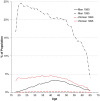Mobile phones and multiple sclerosis--a nationwide cohort study in Denmark
- PMID: 22558088
- PMCID: PMC3340386
- DOI: 10.1371/journal.pone.0034453
Mobile phones and multiple sclerosis--a nationwide cohort study in Denmark
Abstract
We investigated the risk of, prognosis of and symptoms of multiple sclerosis (MS) among all Danish residents who owned a mobile phone subscription before 1996. Using the Danish Multiple Sclerosis Registry and Civil Registration System, study subjects were followed up for MS through 2004. Poisson models were used to calculate incidence rate ratios (IRR, age range: 18-64 years) and mortality rate ratios (MRR, age range: 18+) and to compare presenting symptoms among subscribers and all non-subscribers. A total of 405 971 subscription holders accrued four million years of follow up, with men accounting for 86% of the observation time. Among subscription holding men, the IRR of MS was close to unity, overall as well as 13+ years after first subscription (IRR 1.02, 95% CI: 0.48-2.16). Among women, the IRR was 3.43 (95% CI: 0.86-13.72) 13+ years after first subscription, however, based on only two cases. Presenting symptoms of MS differed between subscribers and non-subscribers (p = 0.03), with slightly increased risk of diplopia in both genders (IRR: 1.38, 95% CI: 1.02-1.86), an increased risk of fatigue among women (IRR: 3.02, 95% CI: 1.45-6.28), and of optic neuritis among men (IRR: 1.38, 95% CI: 1.03-1.86). Overall the MRR was close to one (MRR: 0.91, 95%CI 0.70-1.19) among MS-patients with a subscription and although we observed some increased MRR estimates among women, these were based on small numbers. In conclusion, we found little evidence for a pronounced association between mobile phone use and risk of MS or mortality rate among MS patients. Symptoms of MS differed between subscribers and nonsubscribers for symptoms previously suggested to be associated with mobile phone use. This deserves further attention, as does the increased long-term risk of MS among female subscribers, although small numbers and lack of consistency between genders prevent causal interpretation.
Conflict of interest statement
Figures
Similar articles
-
Use of mobile phones and risk of brain tumours: update of Danish cohort study.BMJ. 2011 Oct 19;343:d6387. doi: 10.1136/bmj.d6387. BMJ. 2011. PMID: 22016439 Free PMC article.
-
Long-term mobile phone use and the risk of vestibular schwannoma: a Danish nationwide cohort study.Am J Epidemiol. 2011 Aug 15;174(4):416-22. doi: 10.1093/aje/kwr112. Epub 2011 Jun 28. Am J Epidemiol. 2011. PMID: 21712479
-
Mobile phone use and the risk of skin cancer: a nationwide cohort study in Denmark.Am J Epidemiol. 2013 Jul 15;178(2):190-7. doi: 10.1093/aje/kws426. Epub 2013 Jun 20. Am J Epidemiol. 2013. PMID: 23788669
-
Electromagnetic fields and health effects--epidemiologic studies of cancer, diseases of the central nervous system and arrhythmia-related heart disease.Scand J Work Environ Health. 2004;30 Suppl 1:1-30. Scand J Work Environ Health. 2004. PMID: 15255560 Review.
-
Gender differences in multiple sclerosis epidemiology and treatment response.Dan Med J. 2016 Mar;63(3):B5212. Dan Med J. 2016. PMID: 26931196 Review.
Cited by
-
Open Questions on the Electromagnetic Field Contribution to the Risk of Neurodegenerative Diseases.Int J Environ Res Public Health. 2022 Dec 2;19(23):16150. doi: 10.3390/ijerph192316150. Int J Environ Res Public Health. 2022. PMID: 36498223 Free PMC article. Review.
-
Relationship between the use of electronic devices and susceptibility to multiple sclerosis.Cogn Neurodyn. 2019 Jun;13(3):287-292. doi: 10.1007/s11571-019-09524-1. Epub 2019 Feb 2. Cogn Neurodyn. 2019. PMID: 31168332 Free PMC article.
References
-
- Cardis E, Deltour I, Mann S, Moissonnier M, Taki M, et al. Distribution of RF energy emitted by mobile phones in anatomical structures of the brain. Phys Med Biol. 2008;53:2771–2783. - PubMed
-
- Dimbylow PJ, Mann SM. SAR calculations in an anatomically realistic model of the head for mobile communication transceivers at 900 MHz and 1.8 GHz. Phys Med Biol. 1994;39:1537–1553. - PubMed
-
- Baan R, Grosse Y, Lauby-Secretan B, El GF, Bouvard V, et al. Carcinogenicity of radiofrequency electromagnetic fields. Lancet Oncol. 2011;12:624–626. - PubMed
-
- Bronnum-Hansen H, Koch-Henriksen N, Stenager E. Trends in survival and cause of death in Danish patients with multiple sclerosis. Brain. 2004;127:844–850. - PubMed
-
- Noseworthy JH, Lucchinetti C, Rodriguez M, Weinshenker BG. Multiple sclerosis. N Engl J Med. 2000;343:938–952. - PubMed
Publication types
MeSH terms
LinkOut - more resources
Full Text Sources
Medical


